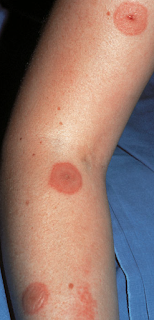Q. A 23-year-old woman is
hospitalised with severe anorexia nervosa. Her FBC shows WBC 3.5 × 109/l,
neutrophil count 1.1 × 109/l, Hb 100 g/l, MCV 104 fl and platelet count 70 ×
109/l. Blood film shows occasional acanthocytes. Neutrophils show normal
segmentation. Her prothrombin time (PT) is slightly increased.
The most likely diagnosis is:
a Aplastic anaemia
b Folic acid deficiency
c Haematological features of
anorexia nervosa
d Hepatic steatosis
e Vitamin B12 deficiency
Ans: c.
Haematological
features of anorexia nervosa
The haematological abnormalities
are all attributable to anorexia nervosa per se and can be related to bone marrow
hypocellularity and gelatinous transformation
Q. A 23-year-old African man who
presents with an epileptiform convulsion and fever is found to have a
microangiopathic haemolytic anaemia, thrombocytopenia and acute kidney injury. The
micro-organism you would test for is:
a Escherichia coli O104:H4
b Escherichia coli O157:H7
c Hepatitis B
d Human herpesvirus 8
e Human immunodeficiency virus
Ans: e.Human immunodeficiency
virus.
Escherichia
coli O157:H7
is the usual cause of haemolytic uraemic syndrome while Escherichia
coli O104:H4
was responsible for a German outbreak of this syndrome in 2011. However this
patient has features suggesting a diagnosis of thrombotic thrombocytopenic
purpura (TTP).1,2 It is important that all patients presenting with TTP are
tested for human
immunodeficiency virus (HIV) since
TTP may be the presenting feature of HIV infection. Some patients with HIV
infection and TTP have a low ADAMTS13 and an ADAMTS13 antibody whereas others
do not have an ADAMTS13 deficiency. Those who are deficient require plasma
exchange as well as highly active anti-retroviral therapy.
Q. An 18-year-old medical student
is permitted to perform an unsupervised venepuncture on a febrile Indian
patient and suffers a needle prick injury. He is anxious that he may have
contracted human immunodeficiency virus (HIV) infection. Assuming that the
patient is infected, transmission is most likely for:
a Dengue fever
b Hepatitis B
c Hepatitis C
d Human immunodeficiency virus (HIV)
e Leishmaniasis
Ans. b
Hepatitis
B.
The infection most readily
transmitted by needle prick injury is hepatitis B with reported transmission
rates of 7−30%, followed by hepatitis C (reported rates 0−7%) then HIV (about
0.5%). Occasional examples of transmission of dengue fever have been reported.
Q. A 33-year-old woman with
systemic lupus erythematosus who has developed livedo reticularis suffers an
unprovoked deep vein thrombosisin her left leg. Her coagulation screen shows a
PT of 16 s (12–14) and an APTT of 40 s (26–33.5). The test most strongly
indicative of your suspected diagnosis would be:
a Anti-β2 glycoprotein 1 antibodies
b Antibodies to the
phosphatidylserine–prothrombin complex
c Anti-cardiolipin antibodies
d Anti-prothrombin antibodies
e Lupus anticoagulant
Ans: e
Lupus
anticoagulant.
The clinical picture suggests the
antiphospholipid syndrome. Livedo reticularisand venous thrombosis are among
the more common features of this syndrome. Guidelines for diagnosis include, as
laboratory criteria, the presence of anti-β2
glycoprotein 1 antibodies, anti-cardiolipin antibodies or the lupus
anticoagulant, in each case the abnormality to be
demonstrated on at least two
occasions, 12 weeks apart.1 Of these abnormalities, the lupus anticoagulant is
the one that most strongly correlates with thrombosis and with fetal loss.






